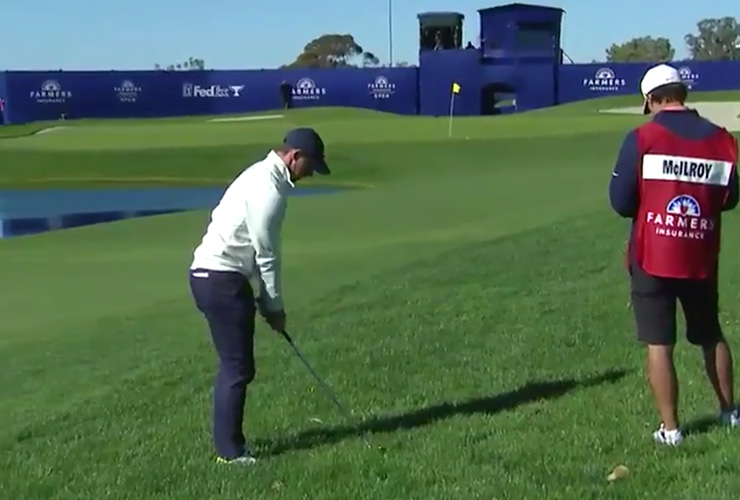By Ryan Herrington
As Patrick Reed’s embedded-ball saga unfolded on Saturday at the Farmers Insurance Open, part of the reasoning for why the PGA Tour stated it was comfortable with the way Reed handled the situation—despite the scepticism of TV commentators and some voices on social media—was that officials believed he acted in a manner consistent with the Rules and with actions typically taken by tour pros in similar situations. As it turns out, there was a similar situation taking place at Torrey Pines that afternoon that helped amplify that later argument.
During his third round, Rory McIlroy played his second shot on the par-5 18th hole from right of the fairway, his ball flying 186 yards and coming to rest in the right rough, 69 yards short of the green. When McIlroy went up to play his third shot, he struggled to find the ball and then when he did, he saw the lie and questioned if his ball was embedded. McIlroy lifted the ball, allowed under Rule 16.4, and determined that the ball indeed was embedded in the wet rough. He then went through the process of taking relief, cleaning the ball and dropping it within a club length. He’d go ahead and hit his third shot short of the green and eventually made a par to finish with two-under 70, leaving him seven under for the tournament and three shots off the lead entering the final round.
MORE: Patrick Reed says he handled his embedded-ball situation ‘perfectly’
Subsequently, video of McIlroy’s shot surfaced, and it added a new wrinkle to the story.
https://twitter.com/PGATOUR/status/1355940124085903364
As was the case in Reed’s situation, video of McIlroy’s ball landing showed that it had actually taken a bounce before coming to rest in the rough, rather than stopping on the fly. In the moment, McIlroy did not know that his ball had taken the hop, which was also the case in Reed’s situation. (What is unclear from McIlroy’s video is whether his ball might have bounced and then fallen back down in his original pitch mark, although McIlroy believed that to be the case.)
Both players deemed that their balls were embedded, which is their right under the rules. The question for many, however, in light of the videos, is whether a ball could realistically embed after such a small hop. It was this gray area that Reed has gotten caught up in, having said himself after his Saturday round that it was “almost impossible” for a ball to embed in that situation, his past rules run-ins also muddying the situation. McIlroy does not have the same past baggage, and was confident that his ball had settled back in his pitch mark.
“So from what happened, like as everyone knows, if a ball bounces up and comes to rest in a pitch mark or in a lie that’s not the pitch mark that it made, then of course it’s very hard for it to be embedded,” McIlroy said after his Sunday round, “but I feel the way my ball was definitely in its own pitch mark, it had to be, and that was why I was so confident to take relief and do what I did.”
With McIlroy’s video released, the PGA Tour issued a statement on Sunday to further clarify the situation in both instances. In the process, the tour reiterated that both players had proceeded correctly given what they knew in the moment.
“John Mutch, Ken Tackett and Gary Young have reviewed the Rory McIlroy videos from No. 18 yesterday and determined that it was virtually the same situation that Patrick Reed faced on No. 10 during the third round. It was reasonable for both players to conclude—based on the fact that they did not see the ball land, but given the lie of the ball in soft course conditions—that they proceed as the Rule allows to an [sic] potentially embedded ball. They marked, lifted and assessed the situation to determine if the ball was embedded. Patrick went one step further and called in a Rules Official to be sure his assessment would not be questioned (although this step is not required). Both players took proper relief under the Rule 16/3. The Committee is comfortable with how both players proceeded given the fact that they used the evidence they had at the time.”









